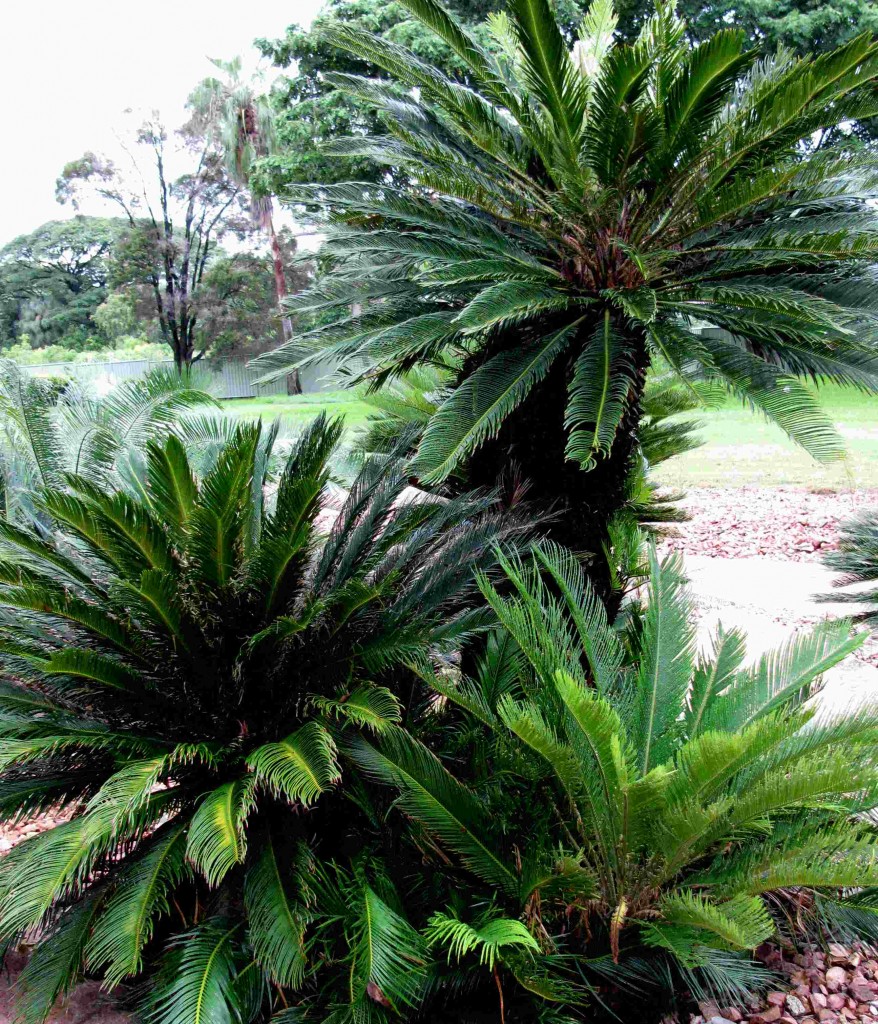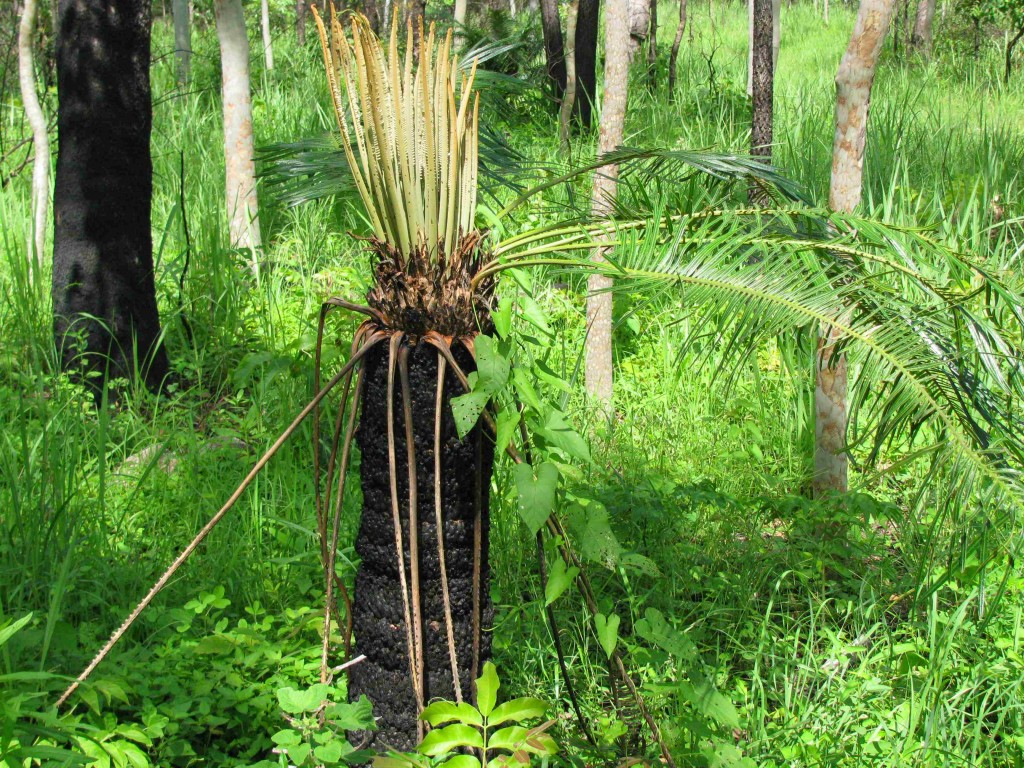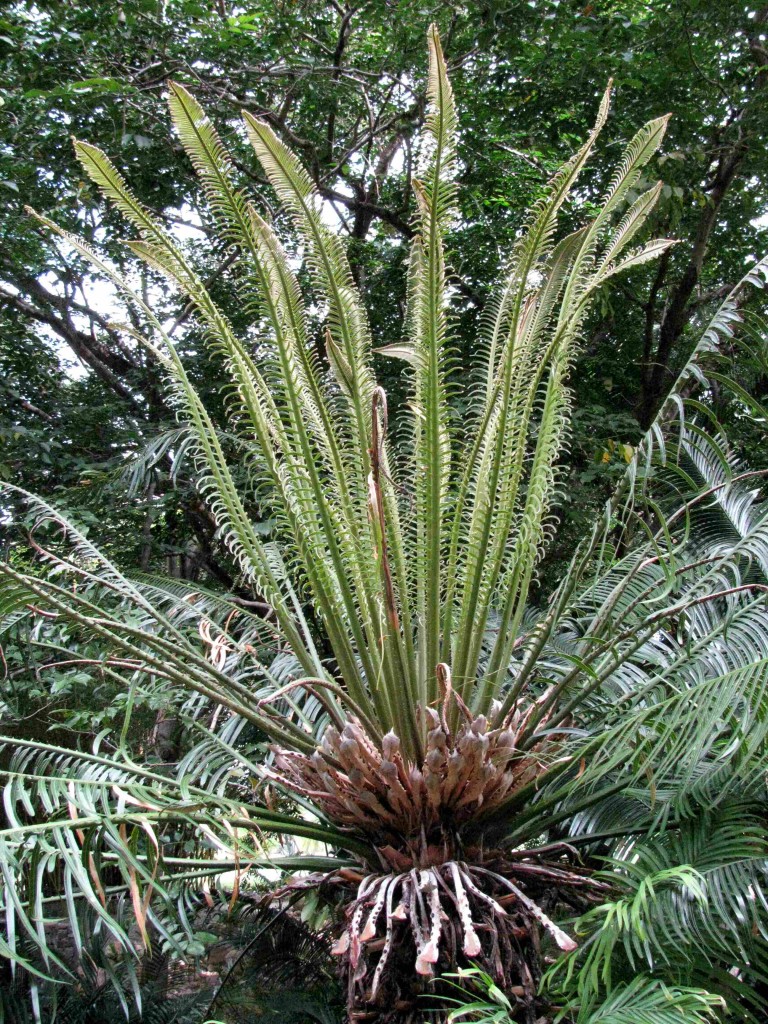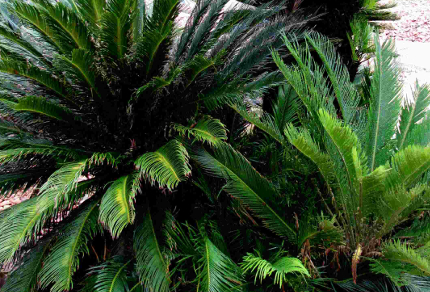
Cycads in Anderson Park Botanical Gardens, Townsville (© Magi Nams)
Until I began exploring Australia, cycads were mysterious plants that grew only in exotic places and belonged to the age of the dinosaurs. However, here in Oz, they’re planted in gardens and grow in the wild. I first knowingly encountered cycads in Townsville’s Queens Gardens on January 2 of this year, my fourth day in Australia. There, in the understory plantings beneath towering trees, cycads flaunted their superficially fern-like leaves in arcing crowns of foliage.
A month later, I explored the city’s Anderson Park Botanical Gardens, which contains cycad gardens featuring native Australian species, plus African and Asian species. As I wandered through these gardens, I observed that the cycads generally possessed long, curved, pinnate leaves that arced up and out from thick, stubby trunks. The leaflets comprising the cycad leaves differed among species, one of the exotic (non-Australian) species having prickly, scalloped edges reminding me of holly, another possessing thin, drooping leaflets, and yet another having firm, robust leaflets with toothed edges. In the Australian section of the garden, I strolled among 15 or so of Australia’s 69 cycad species,1 some dwarf, blue-leaved varieties, others possessing dark green, two-metre leaves comprised of leaflets that resembled dark green stillettos.

Cycad in Tropical Savannah Woodland near Alligator Creek, Bowling Green Bay National Park, Queensland (© Vilis Nams)
In the Australian bush, I first noticed cycads growing in open woodland in Paluma Range National Park in January and alongside Alligator Creek in the Mount Elliot section of Bowling Green Bay National Park in February. Since those early months in this country, I’ve observed them growing in many more locales.
Aussie native cycads inhabit two distinct regions of the country – the southwest knob of Western Australia, and a band of subtropical and tropical vegetation following Australia’s entire east coast and over the top of Queensland westward to the northernmost reaches of the Northern Territory.2 Within these regions, cycads typically grow in open forests, on rocky slopes, or in grasslands at sites with high or medium rainfall.2 One species, however, inhabits arid regions in central Australia.2
All cycads are representatives of a group of plants that truly has survived since the time of the dinosaurs. These are the gymnosperms or ‘naked-seed’ plants, which also include coniferous or cone-bearing trees like the North American spruces, pines, and firs, and the Australian pines and cedars. One of the Australian pines, the Wollemi pine, also shares a history dating back to the time of the dinosaurs. Cycads are the ancestral gymnosperms, however, and as such, predate the existence of all other seed-bearing plants.2

Cycad in Palmetum Park, Townsville (© Magi Nams)
Typically, cycads adopt one of two growth forms – either they have an aboveground, thick, trunklike structure called a caudex that may grow a metre or more tall, or the leaves grow directly from the ground, with the caudex beneath the soil surface.2 The rough, tough outer surface of the caudex is formed from the leaf bases of shed leaves.2 Cycad growth is extremely slow, and in some years, only a few new leaves may unfurl.2 Cycads grow singly in dry habitats, but can form large colonies in wetter habitats.2 Large specimens are thought to possibly be among the earth’s oldest living plants.2
A cycad plant is either male or female, with each gender producing cones.2 Those of the male plants become filled with pollen that’s released into the air and falls on the plant, where it may be picked up by foraging insects.2 The female cones receive the wind-borne or insect-distributed pollen and produce seeds after fertilization occurs.2 When the seeds are ripe, the female cones open so the seeds are exposed, and thus can fall out to the ground or be eaten.2 Each seed is covered with a fleshy coating edible to birds and mammals, which eat the coating and discard the seed, thus ensuring its dispersal.2
So, cycads may be ancient, but their diversity and abundance in Australia and other Old World tropical and subtropical countries are testaments to their success in the game of survival. What they do works.
References:
1. Australian Systematic Botany Society Inc. ASBS Newsletter – Book Review: Flora of Australia, Volume 48: Ferns, Gymnosperms and Allied Groups. © ASBS 1994-2010. Updated 10-Mar-2010. Accessed 22-Sep-2010. http://www.anbg.gov.au/asbs/newsletter/book-review-99c.html
2. Jim Oliff. Australian Native Plants Society, Australian Plants online: Australian Cycads. 2009. Accessed 22-Sep-2010. http://anpsa.org.au/APOL2009/feb09-s3.html


